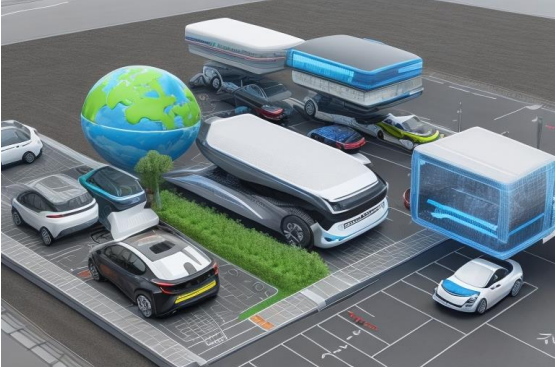The Future of Electric Vehicles: Navigating the Intersection of AI, Cloud Technology, and Cybersecurity

Submission to VIJ 2024-04-22
Keywords
- Electric Vehicles (EVs), Artificial Intelligence (AI), Cloud Technology, Cybersecurity, Autonomous Driving, Battery Management, User Experience, Sustainability, Transportation Network, Automotive Industry
Copyright (c) 2024 Hassan Rehan

This work is licensed under a Creative Commons Attribution 4.0 International License.
Abstract
The emergence of electric vehicles (EVs) represents a paradigm shift in transportation, offering not only the promise of reduced carbon emissions but also the potential for enhanced sustainability and innovation. However, the full realization of EVs' transformative capabilities extends beyond mere electrification; it encompasses the integration of state-of-the-art technologies such as Artificial Intelligence (AI) and Cloud Computing. This meticulously crafted research article delves into the profound impact of AI and cloud technologies on the EV landscape within the United States. It meticulously examines how these technological advancements are reshaping EV ecosystems, catalyzing advancements in autonomous driving, optimizing battery management systems, and enriching user experiences. Furthermore, it elucidates the imperative need for robust cybersecurity measures to fortify these sophisticated systems against cyber threats, thereby ensuring the integrity, privacy, and stability of the transportation network.
With a diverse audience in mind, including automotive industry professionals, policymakers, cybersecurity experts, environmental advocates, technology enthusiasts, and the broader public, this article serves as a beacon illuminating the future of transportation, sustainability, and digital security within the realm of EVs. Through a blend of rigorous analysis, insightful commentary, and visionary foresight, it aims to provide profound insights into the trajectory of EV technology in the United States and beyond.
References
- Gong, C., Liu, J., Zhang, Q., Chen, H., & Gong, Z. (2010, September). The characteristics of cloud computing. In 2010 39th International Conference on Parallel Processing Workshops (pp. 275-279). IEEE.
- Khan, S. K., Shiwakoti, N., Stasinopoulos, P., & Chen, Y. (2020). Cyber-attacks in the next-generation cars, mitigation techniques, anticipated readiness and future directions. Accident Analysis & Prevention, 148, 105837.
- Mo, T., Li, Y., Lau, K. T., Poon, C. K., Wu, Y., & Luo, Y. (2022). Trends and emerging technologies for the development of electric vehicles. Energies, 15(17), 6271.
- Jang-Jaccard, J., & Nepal, S. (2014). A survey of emerging threats in cybersecurity. Journal of computer and system sciences, 80(5), 973-993.
- Vermesan, O., John, R., Pype, P., Daalderop, G., Kriegel, K., Mitic, G., ... & Waldhör, S. (2021). Automotive intelligence embedded in electric connected autonomous and shared vehicles technology for sustainable green mobility. Frontiers in Future Transportation, 2, 688482.
- Mohan Raja Pulicharla, D. Y. (2023). Neuro-Evolutionary Approaches for Explainable AI (XAI). Eduzone: International Peer Reviewed/Refereed Multidisciplinary Journal, 12(1), 334-341.
- Rehan, H. (2024). AI-Driven Cloud Security: The Future of Safeguarding Sensitive Data in the Digital Age. Journal of Artificial Intelligence General science (JAIGS) ISSN: 3006-4023, 1(1), 47-66.
- Song, J., He, G., Wang, J., & Zhang, P. (2022). Shaping future low-carbon energy and transportation systems: Digital technologies and applications. IEnergy, 1(3), 285-305.
- Rehan, H. (2024). Revolutionizing America's Cloud Computing the Pivotal Role of AI in Driving Innovation and Security. Journal of Artificial Intelligence General science (JAIGS) ISSN: 3006-4023, 2(1), 189-208.
- Sarker, M. (2022). Towards Precision Medicine for Cancer Patient Stratification by Classifying Cancer By Using Machine Learning. Journal of Science & Technology, 3(3), 1-30.
- Asaju, B. J. (2024). Enhancing V2X Communication Security Advanced Encryption and Authentication Protocols. Human-Computer Interaction Perspectives, 4(1), 28-56.
- Pulicharla, M. R. (2023). Hybrid Quantum-Classical Machine Learning Models: Powering the Future of AI. Journal of Science & Technology, 4(1), 40-65.
- Ramirez, J. G. C. (2024). Transversal Threats and Collateral Conflicts: Communities of the United States under the siege of political conflicts on the American continent. International Journal of Culture and Education, 2(1). https://doi.org/10.59600/ijcae.v2i1.14
- Asaju, B. J. (2024). Standardization and regulation of V2X cybersecurity: analyzing the current landscape, identifying gaps, and proposing frameworks for harmonization. Advances in Deep Learning Techniques, 4(1), 33-52.
- Vermesan, O., John, R., Pype, P., Daalderop, G., Kriegel, K., Mitic, G., ... & Waldhör, S. (2021). Automotive intelligence embedded in electric connected autonomous and shared vehicles technology for sustainable green mobility. Frontiers in Future Transportation, 2, 688482.
- Sohal, A. S., Sandhu, R., Sood, S. K., & Chang, V. (2018). A cybersecurity framework to identify malicious edge device in fog computing and cloud-of-things environments. Computers & Security, 74, 340-354.
- Altowaijri, S. M. (2021). Reducing Cybersecurity Risks in Cloud Computing Using A Distributed Key Mechanism. International Journal of Computer Science & Network Security, 21(9), 1-10.
- Pulicharla, M. R. Explainable AI in the Context of Data Engineering: Unveiling the Black Box in the Pipeline.
- Salah, K., Hammoud, M., & Zeadally, S. (2015). Teaching cybersecurity using the cloud. IEEE Transactions on Learning Technologies, 8(4), 383-392.
- Ahmad, W., Rasool, A., Javed, A. R., Baker, T., & Jalil, Z. (2021). Cyber security in iot-based cloud computing: A comprehensive survey. Electronics, 11(1), 16.
- Asaju, B. J. (2024). Cybersecurity Frameworks for Autonomous Vehicle Systems: Safeguarding Onboard Systems, Communication Networks, and Data Privacy in Smart City Ecosystems. Internet of Things and Edge Computing Journal, 4(1), 27-48.
- Marston, S., Li, Z., Bandyopadhyay, S., Zhang, J., & Ghalsasi, A. (2011). Cloud computing—The business perspective. Decision support systems, 51(1), 176-189.
- Lee, Z., Wu, Y. C., & Wang, X. (2023, October). Automated Machine Learning in Waste Classification: A Revolutionary Approach to Efficiency and Accuracy. In Proceedings of the 2023 12th International Conference on Computing and Pattern Recognition (pp. 299-303).